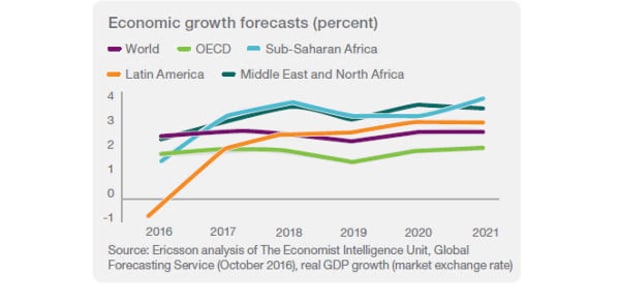advertisement
5G subscriptions to hit half billion in 2022: Ericsson Mobility Report
The latest edition of the Ericsson Mobility Report forecasts that there will be 550 million 5G subscriptions in 2022. From…

The latest edition of the Ericsson Mobility Report forecasts that there will be 550 million 5G subscriptions in 2022. From 2016 to 2022, Sub-Saharan Africa will dramatically shift from a region with a majority of GSM/EDGE-only subscriptions, to around 83 percent of all subscriptions on WCDMA/HSPA and LTE. North America will lead the way in uptake of 5G subscriptions, where a quarter of all mobile subscriptions are forecast to be for 5G in 2022.
Asia Pacific will be the second fastest growing region for 5G subscriptions, with 10 percent of all subscriptions being 5G in 2022.
This year, Ericsson has published 5 Regional Reports with the Global Mobility Report. The Sub-Saharan Africa Mobility Report reveals that while total mobile subscriptions penetration in the region is currently 85 percent, this number is expected to reach 105 percent by 2022 with over 1 billion mobile subscriptions. This makes Sub-Saharan Africa, the region with highest growth rate in mobile subscriptions globally.
advertisement
By the end of 2016, there will be 3.9 billion smartphone subscriptions globally. Almost 90 percent of these subscriptions will be registered on WCDMA/HSPA and LTE networks. By 2022, the number of smartphone subscriptions is forecast to reach 6.8 billion, with more than 95 percent of the subscriptions registered on WCDMA/HSPA, LTE and 5G networks. In Sub-Saharan Africa smartphones penetration will reach around 80 percent by 2022 while mobile subscriptions on smartphones will rise by 21 percent annually from 2016 to 2022.
The report also highlights the role Internet of Things plays in providing new means to deliver efficient, innovative solutions that meet socio-economic challenges and transform business models to unlock growth in sub-Saharan Africa. Across sub-Saharan Africa, the report projects cellular IoT connections growing from 11 million in 2016 to 75 million connections in 2022.
The latest Ericsson Mobility Report also forecasts that in 2022, there will be 8.9 billion mobile subscriptions, of which 90 percent will be for mobile broadband. At this point in time, there will be 6.1 billion unique subscribers.
advertisement
As of Q3 2016, 84 million new mobile subscriptions were added during the quarter to reach a total of 7.5 billion, growing at around 3 percent year-on-year. India grew the most in terms of net additions during the quarter (+15 million), followed by China (+14 million), Indonesia (+6 million), Myanmar (+4 million) and the Philippines (+4 million). Mobile broadband subscriptions are growing by around 25 percent year-on-year, increasing by approximately 190 million in Q3 2016 alone. The total number of mobile broadband subscriptions is now around 4.1 billion.
Mobile data traffic continues to grow, driven both by increased smartphone subscriptions and a continued increase in average data volume per subscription, fueled primarily by more viewing of video content. In Q3 2016, data traffic grew around 10 percent quarter-on-quarter and 50 percent year-on-year.
A rise in access and viewing of video content is also a driver for mobile data traffic growth in Sub-Saharan Africa. Other drivers are wider network coverage, continued reduction in prices of both devices and services and a growing population with 57% of the current population under 15 years old.
advertisement
Jean-Claude Geha, President of Ericsson Sub-Saharan Africa says: “Data traffic is forecast to grow by around 55 percent annually between 2016 and 2022 , that is a 13 times growth. This rapid growth is driving operators to explore methods of optimizing network capacity, one of which is complementing traffic via Wi-Fi networks – with traffic expected to rise 70% annually between 2016 and 2022.”